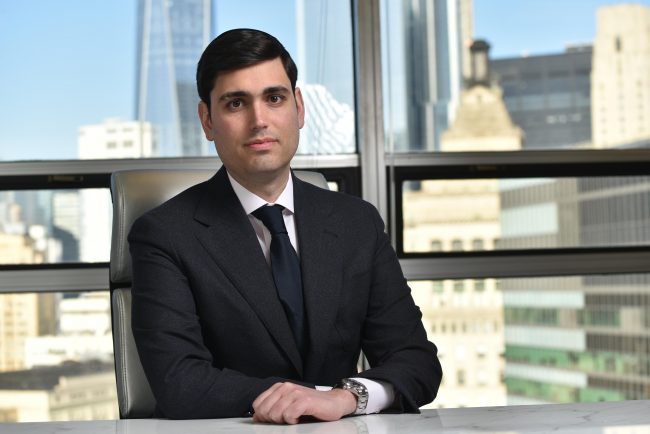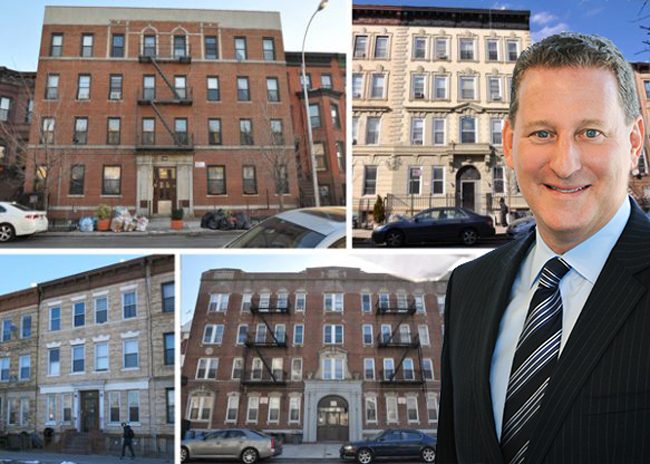After winning an assignment last summer for an outer-borough multifamily package, Aaron Jungreis jogged his memory for potential buyers.
“You always go to that top line – the junkies,” said Jungreis, the president of Rosewood Realty Group, one of the city’s most active multifamily brokerages. “And the second level are guys who are not as prone to risk.”
Then came the final tier, one that multifamily brokers increasingly turned to in the past year while the market softened significantly. “When you really can’t sell anything, you go to those who are not that reliable,” he said. “If that doesn’t work, then you’re in trouble.”
Despite some heightened broker hustling, the city’s multifamily market took a punch to the mouth in 2017. Dollar volume hit $7.22 billion, its lowest level since 2011 and a 48 percent drop, according to data from Ariel Property Advisors. Deal volume, at 457 trades, was at a seven-year low. Pricing remained high and even the go-to multifamily buyers scaled back.
The Real Deal spoke to dozens of landlords and multifamily brokers over recent months about the market’s ups and downs.
People have waited for a crash that didn’t happen.
Multifamily portfolios all but vanished from the market. The days of the $300 million, multi-borough portfolio deal – that firms such as Douglas Eisenberg’s A&E Real Estate Holdings, Heller Realty and Peter Rebenwurzel’s Coney Realty Group sought out just two years ago – appeared long gone. During that time, the market also saw a huge boost from one outlier: Blackstone Group and Ivanhoe Cambridge’s $5.3 billion purchase of Stuyvesant Town-Peter Cooper Village in 2015.
“I do sometimes go out and canvas for less obvious buyers,” said Jungreis, “because there’s more time to do that when it’s slow.”
The segment that has been hit the most in the past year has been $100 million-to-$200 million space, where the pace of deal closings has significant slowed, sources said.
Owners and brokers have both found themselves spending more time in the lower end of the market, tackling deals in the $10 million and $20 million range because, Jungreis said, “they’re more moveable.”
The overall level of uncertainty has made some players desperately long for a market collapse, which would at least offer some clarity.
“I almost wish there were a crash, so we could actually hit bottom,” said one high-level multifamily source. “We don’t know where we are.”
Still, the tail end of 2017 and the beginning of 2018 may hint to a twist: a sudden uptick in multifamily sales and a wave of optimism among industry players.
Getting in the door
In 2017, a tapestry of factors eliminated several types of buyers from the running altogether. The short-term investors have largely faded from view. Stalwarts like Treetop Development and Black Spruce Management, for example, have quieted down their shopping sprees.
“The buyers with a three-to-five-year hold thesis have almost evaporated,” said Meridian Capital Group’s David Schechtman.
Seasoned brokers said the fewer players still buying at the moment are local families and investors looking to wrap up 1031 exchanges. Sources said much of that remaining buyer pool is on the sidelines, waiting for pricing to adjust.
“People have waited for a crash that didn’t happen,” said Adam Hess of Brooklyn brokerage TerraCRG.
The need for a forceful marketing push has therefore made the elusive “off-market deal” a rarer thing.
“Deals used to come together on their own,” said Peter Von Der Ahe of Marcus & Millichap.
That gulf on pricing between buyers and sellers has resulted in fewer fantastical asking prices becoming a reality upon closing.
“There is less fervor for deals that are wildly priced,” Schechtman said, “and there is no fervor for deals that are not intelligently priced.”
And there’s another intractable factor fueling the standoff between buyers and sellers: lenders. Sources said prominent multifamily lenders such as Wells Fargo, Signature Bank and private equity firm Mesa West Capital are not saying no to borrowers so much as cutting down on the proceeds. Even proven, reliable borrowers may get $10 million less on a $40 million purchase these days, sources said.
In that sense, lenders are able to control who is borrowing – and therefore who is buying.
“The problem is, when lenders pull back, the buyers can’t find equity,” said Von Der Ahe. “Equity is more expensive than debt.”
Hodges Ward Elliot’s Daniel Parker said owners that would have wanted 70 percent loan-to-value are now hoping to get 60 to 65 percent. “But I’m also seeing buyers who are comfortable with lower leverage at 50 percent, even if 65 percent is available,” he said.
Recycling day
Wanda Pearson, CEO of RSA Mortgage Brokerage, said investors are scrambling to get their cash out of buildings at decent rates. While they vary depending on repayment terms, rates for a multifamily deal today would likely be 25 to 50 basis points higher than in the fourth quarter of 2017, she said.
“The disparity is astounding,” Pearson said. “The solution is to only cash out some.”
And investors said they have been experiencing a jolt of déjà vu, seeing buildings come back on the market over and over again with a lower price point – until someone eventually buys.
Akelius Real Estate Management, the U.S. subsidiary of a major Swedish landlord, bought a pair of Chelsea buildings for $100 million in August. But it was far from the first time Akelius’ New York head had seen them.
“We’re seeing deals, but they’re most recycled older deals, ones that were shopped in 2015 and 2016,” said Akelius’ Kunal Chothani. “We first looked in the Chelsea buildings at 2015 at a much higher price. But at a higher rent roll and a new seller expectation, we made a deal. Twenty percent is a real difference.”
HWE’s Parker said he’s increasingly seeing institutional investors among the stable of long-term players going after workforce housing, primarily in the outer boroughs.
One major example was Boston-based private equity firm Rockpoint Group and partner Brooksville Company’s $905 million pending purchase of Starrett City in Brooklyn, in what was the largest multifamily deal to enter contract in the city this year. The 5,881-unit housing complex, the largest federally subsidized one in the U.S., is expected to remain affordable under an agreement for long-term ownership.
The portfolio game
Last year, Silvershore Properties unloaded onto the market 57 rent-stabilized buildings, more than half of the firm’s New York City holdings.
In New York City’s multifamily world, portfolio trades are commonplace – an assortment of rental buildings of different sizes and in different neighborhoods, ready to be snatched up in one fell swoop. From 2014 to 2016, billions of dollars were transacted for buildings by the busload – from the $690 million purchase of the 24-building Caiola portfolio and the $357.5 million purchase of the 47-building Dawnay Day portfolio.

Isaac Kassirer
And yet, in 2017, that package – nicknamed “the Brooklyn Legacy portfolio” – was very, very alone.
On an island of its own, the gargantuan Brooklyn-centric package — the only massive portfolio being actively marketed — has been floating on the market since the spring. Cushman’s Stephen Palmese, who was marketing the portfolio for sale, was enthusiastic late last year. He said it “was the most viewed portfolio in Cushman’s history.”
After nearly six months on the block though, Silvershore opted to try to sell it in several tranches through individual brokers, sources said.
One reason why the 57-building Silvershore portfolio listing was an anomaly in 2017 is because brokers have been advising people against putting so much real estate up on the block at once.
“The demand has been extremely high and there has been an overwhelming amount of requests to break up the portfolio,” said Palmese.
Hess, of TerraCRG, said he recommends marketing one or two buildings at a time, especially while the $10 million-to-$20 million market is going strong.
“Packages were coming on the market with low cap rates and it didn’t make sense,” Hess said. “You’ll see less of those on the market.”
One that recently entered the fray is Alchemy Properties and Alcion Ventures’ nine-building, 113-unit Brooklyn portfolio, which has a high sticker price at $530,000 per unit.

Clockwise from top left: 216 Macon Street, 475 Hancock Street, 910 Prospect Place, 442 Decatur Street 45 Kingston Avenue and Ken Horn
A few packages snuck through to the finish line last year, including A&E’s $83 million, seven-building purchase in Queens, Oak Tree Residential and Management’s $76 million, 18-building purchase in Brooklyn, and Isaac Kassirer’s nearly $100 million, three-building purchase on the Upper West Side.
There has been an uptick in refinancing instead of selling, as BCB Property Management did on a six-building, Upper West Side-centric portfolio asking $125 million. The firm secured $72 million from Square Mile Capital Management as an alternative.
“People used to say there is a ton of upside to multifamily,” Marcus & Millichap’s Anton said. “Now they’re backing off.”
Uncharted territory
The prime multifamily markets of Brooklyn, Queens and northern Manhattan have in some ways taken a backseat to Manhattan, where demand remains strong.
While Manhattan – from Midtown to the Financial District – offers more valuable multifamily product, some brokers specializing in the outer boroughs have been spending more time there as of late.
“There are better deals in Manhattan than in the boroughs right now,” said HPNY’s Ivan Hakimian. “There’s opportunity there.”
In one of the quicker turnarounds this year for a large multifamily deal, the Karten family began marketing the 320-unit rental building the Vogue at 990 Sixth Avenue in May through Cushman & Wakefield, and by September, the deal was in contract with Vanbarton Group for $320 million, or $1 million per door.
Amid the renewed interest in Manhattan, buyers aren’t branching into new, untapped neighborhoods in the outer reaches of the city to the extent they were just a couple years ago, sources said.
Chothani said he’s focused on the areas in which they already own, including Crown Heights, Prospect-Lefferts Gardens and neighborhoods south of Central Park.
The question is how long investors will continue playing it safe. Hess predicts that by second quarter of 2018, bigger multifamily sales will pick up the pace and begin closing at a steady pace again.
People used to say there is a ton of upside to multifamily. Now they’re backing off.
Already, in the past two months, there have been signs of hope. Taconic Investment Partners is buying 12 Bronx buildings from Related Companies, Ben Soleimani is buying 15 Bronx buildings from Isaac Kassirer and Blackstone recently took Harvard Management Company’s majority stake in an A&E package. Von Der Ahe cited a few hotbeds of supply such as the Far West Side, Downtown Brooklyn and Long Island City where new-development rentals strive to keep the multifamily space alive.
“The market isn’t necessarily dead – you just need to pick your spots,” Von Der Ahe said. “Neighborhoods are pretty consistent.”
